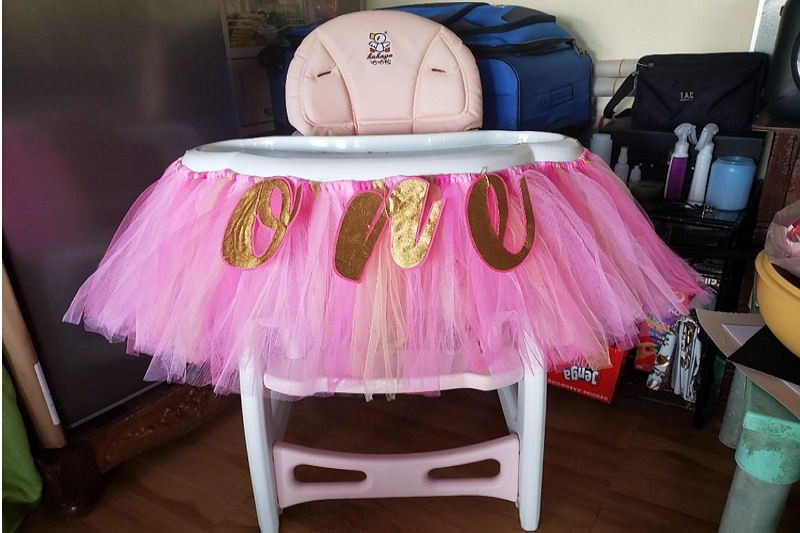In this blog post, you will learn How to make a highchair tutu. The steps are easy and simple to follow. Read on.

Steps to Create a Highchair Tutu
Step 1. Tie two large bows onto the back of your highchair. Trim any loose, hanging threads from the edges of each bow so they don’t snag on anything when the baby leans forward or moves around in her seat.
Step 2. Cut off about eight inches (20 cm) of tulle and tie it into small loops with double knots. This will be used for trimming at various lengths along one edge of both bows.
Step 3. Make sure you do this over something that can catch all those little pieces like an old towel or piece of cardboard because there are going to be quite a few!
Once you have tied loops every couple inches up one long edge of each bow, cut another strip (about eight inches/20 cm) of tulle and tie it securely around the centre of each bow with double knots.
This will be used to attach one end of a hair elastic, so make sure that this length is just enough to wrap around both bows plus about an inch or two (about three centimetres).
Step 4. Once you have tied your knot at each side, cut another piece of tulle into four even strips measuring about two inches wide (five centimetres). Tie them tightly in place on either side by inserting the ends through the looped strip underneath.
Step 5. Now trim any loose threads from these pieces as well before cutting off any excess fabric if needed — depending on how long your loops are they may not overlap completely, but for best results keep them as even as possible.
Step 6. The next steps will involve tying a piece of elastic around the loops at each end and teasing out some fabric from between one loop and another to make it look fuller.
Step 7. Cut off about four inches (ten centimetres) of elastic, measuring from where you tied both knots at either side, then tie an overhand knot in the centre with your remaining length so that it forms two loops.
These are going to be used for pulling hair through later! Now tease apart all those small pieces along one edge again by inserting the pointy end of your scissors into gaps between loops or just under loose threads until there is enough room to fit a finger underneath.
Step 8. Make sure you do this carefully if you pull too hard on the loops, they will become undone. Now cut off two more pieces of elastic measuring about four inches (ten centimetres) in length and tie them onto each end to make them look like bows again.
Make sure you do this over something that can catch all those little pieces or loop the loose ends back through a few times for safety purposes!
Highchair tutu completed. This is a great way to add some flair to your baby’s high chair while making it safer for when she starts learning how to eat on her own from the table without help.
You can also use these same steps with any other seat where you would want an extra bit of detail such as swings, bouncy chairs, etc. The possibilities are endless!
What happens if a preemie failed the car seat test?
If your preemie child fails the car seat test, you may need to get a new car seat. There are many types of convertible and combination seating available that will fit smaller babies better than infant seats do (and if they pass). You can try other brands or models until you find one that fits well.
Some parents also switch their baby into an infant carrier once he reaches his adjusted age and weight limit, because it is much easier to carry him out of the house in this type of seat rather than trying to lug around a heavy rear-facing toddler seat while wearing your newborn everywhere!
If neither option works for you due to budget constraints or preference, please bring your child back at another visit so we can help make sure she has a safe ride home.
Why do hospitals check car seats?
If you are driving your small child, or children to the hospital in a car seat, why do hospitals like them? The answer is simple – because it makes sense.
After all, there is nothing worse than getting an injured child who needs medical attention and then having to take time putting their carseat back on when they arrive at the emergency room.
It’s much easier if everyone arrives safe and sound with their own safety devices already attached! So remember that whenever possible, bring along your little ones’ cars seats when visiting the ER for any reason (including accidents).
If not, however, make sure they’re strapped into something comfortable which will keep them nice and secure during the journey. Another thing you may want to think about bringing along is items to keep your child entertained while you wait for medical attention.
What makes a baby fail a carseat test?
A true carseat test puts the baby in a simulated accident situation. This means testing how the harness and seatbelt would hold up to an emergency stop, sudden impact or rollover of some kind with all elements working properly (including airbags if present) and no modifications done to either the vehicle or infant carrier itself.
A good way to think about it: If your child were riding in another person’s care, would you accept their word on whether they passed? Or do you need proof beyond what they say? Vehicle safety experts advise making sure any caregiver can pass such a test before handing over your precious cargo!
